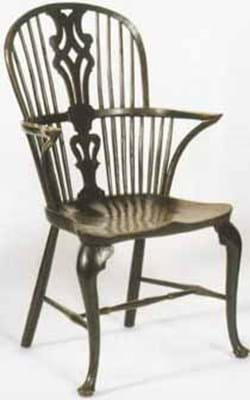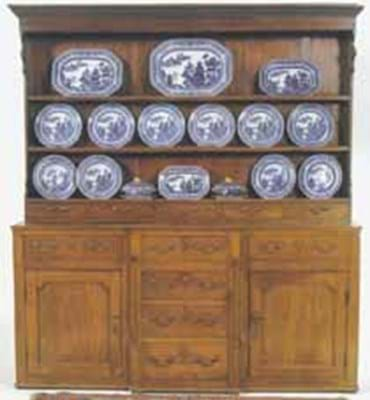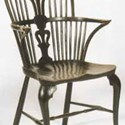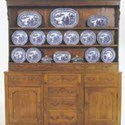Lacking any huge stars, the day returned the sort of figures - a total of £130,000 and an 83 per cent success rate - that used to allow auctioneers to sleep at night with only the prospect of an early-morning house clearance to disturb their dreams.
"It's a selective market but the good will rise and the bad will fall," said a philosophical Mr Papworth.
Also adding some reassurance that the old market is not entirely dead was the way old favourites dominated the higher reaches of the sales list - lots such as a set of Windsor chairs, a Steiff bear and a plaque painted by James Stinton.
The Windsor chair were classics of their kind. Offered as a set of five - bidders were told only four actually matched but country furniture has less formal rules - they were yew and elm elbow chairs dating to the late 18th century with pierced central splat, stick backs and solid saddle seats raised on cabriole legs. Estimated at up to £2500 they sold to the local trade at £7800.
Another nod to country furniture's continued popularity was the catalogue illustration of a good George III oak dresser.
Standing 6ft 5 1/2in high by 5ft 8 1/2in wide (1.97 x 1.74m) it had a three-tier plate rack above a row of four spice drawers on a breakfront base with four graduated drawers flanked by reeded columns, outer drawers and panelled cupboards. Estimated at £2000-2500, it was another local trade buy at £3900.
Practical dining room mahogany has been a reasonable hedge against the deflation of much antique furniture and, here in East Anglia, a Victorian dining table and a lovely looking George III serving table found buyers at reasonable prices.
The table, extending with three extra leaves to 7ft 9in (2.36m) long and on turned and fluted legs, took £2500 from a private bidder against hopes of up to £1200, while the 7ft (2.13m) breakfront serving table went to the London trade at £3700, double the mid estimate.
There was also some signs of encouragement in the reaction to a Victorian figured walnut and ormolu-mounted credenza.
Measuring 6ft 1in (1.85m) wide, it was undoubtedly a good piece of its kind, with veneered frieze above a central oval marquetry panel door flanked by female gilt-metal stiles and glazed bowed doors flanked by conforming stiles. door. Six years or so ago it would have fetched more, but last year it mightn't have sold at all and the within-estimate £3400 trade bid seemed a good sign.
One area that has moved steadily up the price scale has been that of barometers to the extent that good 19th century examples are now responding to the underlying pressure of prices for earlier works.
Here an early 19th century, chequer-strung, mahogany stick example was a major attraction among the horology. Signed F.R. Willats, 98 Cheapside London, the 3ft 1 1/2in (95cm) barometer had a broken arch pediment above a hinged glazed door enclosing a silvered registered plate and thermometer. It went to a private enthusiast a little above top estimate at £1750.
Placed among the works of art in the catalogue, for want of a better category, was an early 20th century Steiff gold plush teddy bear. With jointed limbs and head with stitched elongated nose and the essential button to its ear, the 20 1/2in (52cm) bear sold at £1900.
Top seller among the ceramics had a comfortingly familiar ring to it - a Royal Worcester oval plaque painted by one of the Stinton clan.
Date coded for 1913, the 8 x 5 1/2in (20 x 14cm) plaque painted with a male and female pheasant flying above heather and signed Jas Stinton sold to the trade at £1300.
Old favourites still solid sellers in selective market
THE ups and, more depressingly, the downs of the market this year make the results of a steady day’s selling of material put together by Nigel Papworth at Diamond Mills’ (11.75% buyer's premium) Felixstowe rooms at the end of June look positively encouraging.








